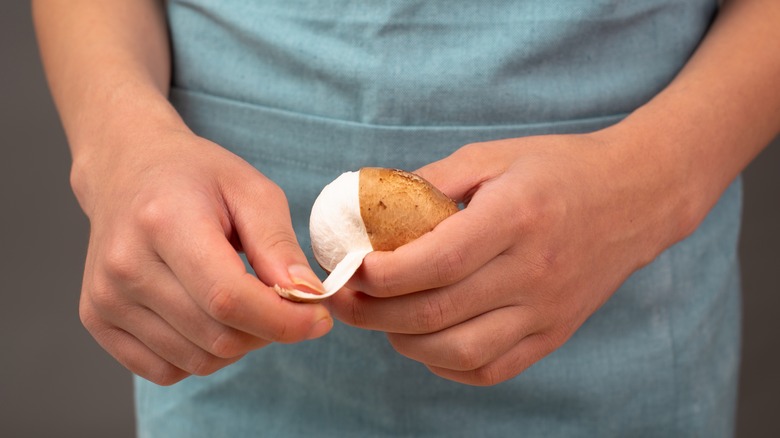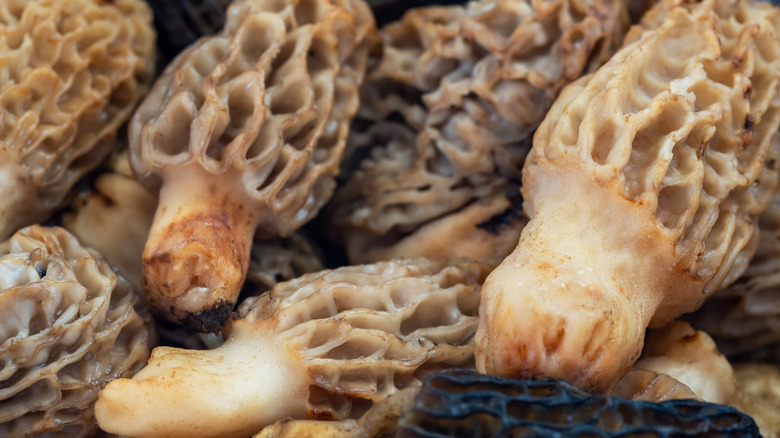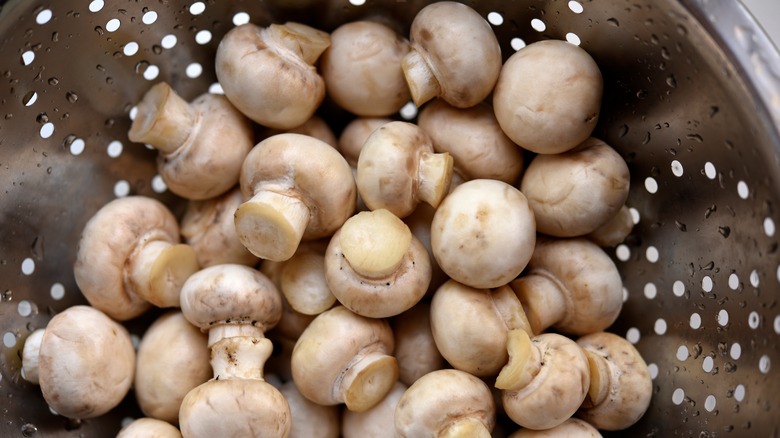To Clean Mushrooms Easily, Start Peeling Them Instead
There is much to love about those umami-rich mushrooms, but there's no denying the fact that they are awfully tiresome little things to clean. Often, you'll spend precious minutes soaking the fungi in water or scrubbing each morsel meticulously by hand to get all that dirt off. But what if there was an easier way to get the job done?
There is a simpler way to clean mushrooms, and rather than washing them, it involves merely peeling off the dirty outer layer. All you need to do is pop off the stem at the bottom of the fungi. Once that is out, turn the cap over, and you'll notice some skin overhanging where the stem was. Peel this back with your fingers, and it will easily slide off in thin strips — no need for any knives or vegetable peelers.
Convenience aside, another reason why you might want to peel the fungi rather than wash them is because they are extremely absorbent sponges. Mushrooms tend to suck up all the liquid when they are soaked or cleaned in water, meaning they will have too much moisture inside when you cook them. They won't brown as easily, nor will they absorb as much flavor as they usually would — both rather unfortunate things, considering how delicious they can be when cooked well.
Not all mushrooms can be peeled
Although this is a stellar way to clean fungi easily, it is important to note that not all of them can or should be peeled. This method only works well when you have smooth, round mushrooms with stems and skins that can be pulled off easily — think meaty portobellos, firm creminis, and little white buttons. However, you won't exactly be able to peel the skins of tiny enoki mushrooms, funnel-shaped chanterelles, or honeycomb-like morels filled with crevices that can hide a lot of dirt and bugs.
Some mushrooms simply require a different approach. For instance, morels are best sliced lengthwise in half once the stems are removed and then rinsed in water. You might even want to clean them like strawberries with a saltwater scrub — a soak in the saline solution will really get the dirt out from all those nooks and crannies. Chanterelles, too, are best cleaned this way with a 20-minute soak in some salted water, as this will get rid of any critters hiding inside. Make sure to dry these properly once they are washed, though — you don't want any lingering moisture getting in the way of perfectly cooked and seasoned mushrooms. You could let them dry in a colander, give them a hearty twirl in a salad spinner, or even pat off the excess moisture with a towel.
Do you even need to clean mushrooms though?
There are plenty of ways to clean mushrooms thoroughly so that not a speck of dirt remains, but have you ever wondered whether it's even necessary to go through all that trouble in the first place? It may seem like an obvious thing to do, since these fungi are often quite mucky. However, this muck isn't always what it appears to be.
Most mushrooms that you buy from stores are cultivated in carefully monitored environments rather than foraged from the wild. The dirt that you see on them is nothing but flecks of the peat compost that they are grown in. Now, you might not want gritty compost in your savory mushroom stews or wild mushroom and red wine risottos, but it's not going to be the end of the world if some of it does accidentally sneak in. This is why you can get away with cleaning most mushrooms by simply wiping them with a dry brush if peeling isn't an option. Alternatively, you could even pat them with a damp paper towel to get rid of the compost.
The only exceptions are mushrooms that look extremely dirty and slimy, or which have hard-to-reach crevices that can't be cleaned without a good soak. You'll also want to thoroughly wash the fungi if they have been foraged from the wild rather than bought from a store — these are the ones that will be covered in grime that should be cleaned meticulously before cooking.



